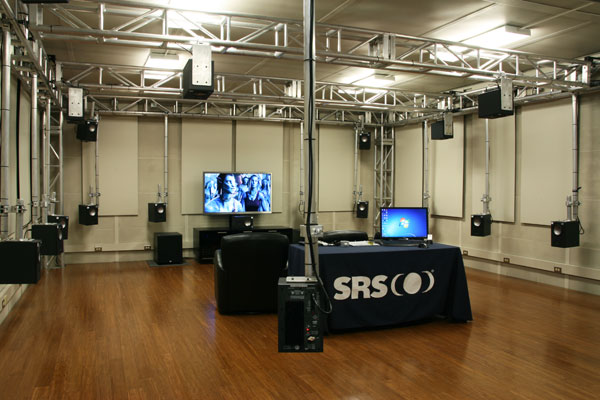SRS Advanced Rendering Lab

A few weeks ago, I visited SRS Labs in Irvine, California, to see—and hear—its new Advanced Rendering Laboratory (ARL). This facility is custom built to test any imaginable physical or psychoacoustic audio system—in other words, it's an audio geek's dream come true.
The ARL is a room-within-a-room measuring 30 x 22 x 9.5 feet and constructed inside a warehouse. A raised floor hides all the cables, and the walls and ceiling are acoustically treated with reflectors and diffusers so the room is not terribly live, but not dead, either.
A stage-rigging company constructed scaffolding throughout the room so any number of speakers can be positioned virtually anywhere. When I visited, there were 20 main speakers (front left, right, center; front left and right wide; front left and right high; six side surrounds; three rear surrounds; four overhead) and two subwoofers. All speakers are self-powered professional monitors from Blue Sky, and the entire audio system carries +4dBu balanced signals.

All signal routing and processing is performed in software running on a Windows computer with a quad-core CPU—in fact, the only other audio hardware in the ARL is a pair of 12-channel MOTU professional audio interfaces, and more can be added as needed. This allows various configurations and algorithms to be instantly compared without having to repatch anything.
During my visit, I heard a demo of a new multidimensional-audio open standard being developed by the 3D Audio Alliance, which is the subject of my recent podcast with SRS CTO and 3DAA president Alan Kraemer. I also heard a demo of a new SRS algorithm that blew me away.
This algorithm, called Circle Cinema 3D Audio (CC3DA), adds the element of depth to a soundtrack by analyzing cues in the mix (phase, amplitude, etc.) and using psychoacoustic tricks to render sounds out in the room or behind the walls. According to Kraemer, this process uses completely different principles than conventional head-related transfer functions (HRTFs), though it uses those as well.
The demo consisted of several clips from Avatar, and Kraemer switched between conventional 5.1 and 2-channel (front left and right) with the CC3DA algorithm. In 2-channel mode, I was amazed to hear sounds appear to emanate from different distances—objects in the foreground sounded closer than objects in the background. When he switched to 5.1, the entire soundfield immediately flattened against the walls. As I remarked at the time, "The 2-channel processed sound is more surrounding than the 5.1!"
Unlike the open-source 3DAA multidimensional-audio standard, which is a couple of years from fruition, CC3DA is an SRS-exclusive algorithm that should appear in consumer products next year, and it seems to be a perfect compliment to 3D video. I'm sure we'll hear more at CES next month, and you can read all about it in my show coverage.
- Log in or register to post comments






























































